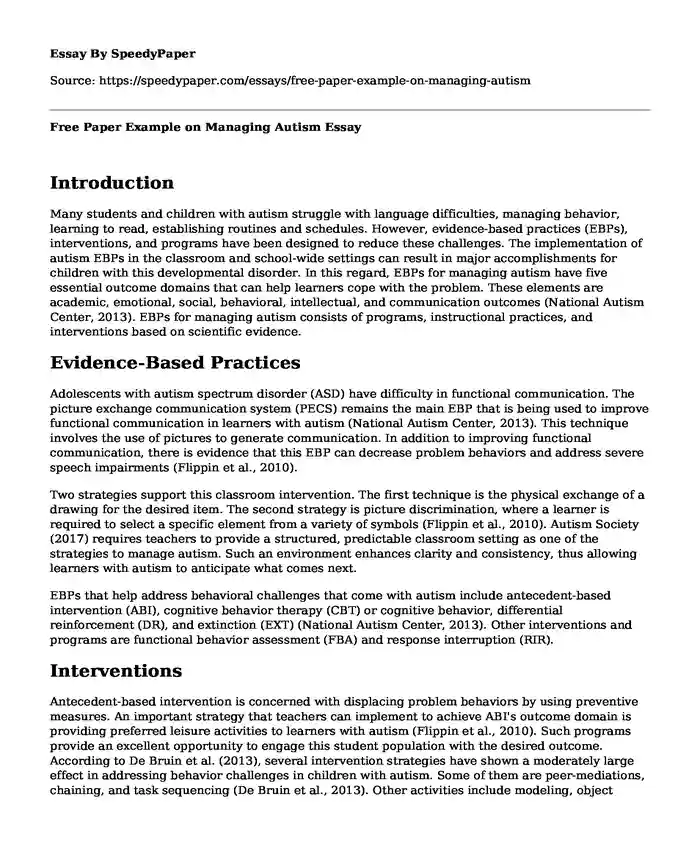
| Type of paper: | Essay |
| Categories: | Autism |
| Pages: | 3 |
| Wordcount: | 821 words |
Introduction
Many students and children with autism struggle with language difficulties, managing behavior, learning to read, establishing routines and schedules. However, evidence-based practices (EBPs), interventions, and programs have been designed to reduce these challenges. The implementation of autism EBPs in the classroom and school-wide settings can result in major accomplishments for children with this developmental disorder. In this regard, EBPs for managing autism have five essential outcome domains that can help learners cope with the problem. These elements are academic, emotional, social, behavioral, intellectual, and communication outcomes (National Autism Center, 2013). EBPs for managing autism consists of programs, instructional practices, and interventions based on scientific evidence.
Evidence-Based Practices
Adolescents with autism spectrum disorder (ASD) have difficulty in functional communication. The picture exchange communication system (PECS) remains the main EBP that is being used to improve functional communication in learners with autism (National Autism Center, 2013). This technique involves the use of pictures to generate communication. In addition to improving functional communication, there is evidence that this EBP can decrease problem behaviors and address severe speech impairments (Flippin et al., 2010).
Two strategies support this classroom intervention. The first technique is the physical exchange of a drawing for the desired item. The second strategy is picture discrimination, where a learner is required to select a specific element from a variety of symbols (Flippin et al., 2010). Autism Society (2017) requires teachers to provide a structured, predictable classroom setting as one of the strategies to manage autism. Such an environment enhances clarity and consistency, thus allowing learners with autism to anticipate what comes next.
EBPs that help address behavioral challenges that come with autism include antecedent-based intervention (ABI), cognitive behavior therapy (CBT) or cognitive behavior, differential reinforcement (DR), and extinction (EXT) (National Autism Center, 2013). Other interventions and programs are functional behavior assessment (FBA) and response interruption (RIR).
Interventions
Antecedent-based intervention is concerned with displacing problem behaviors by using preventive measures. An important strategy that teachers can implement to achieve ABI's outcome domain is providing preferred leisure activities to learners with autism (Flippin et al., 2010). Such programs provide an excellent opportunity to engage this student population with the desired outcome. According to De Bruin et al. (2013), several intervention strategies have shown a moderately large effect in addressing behavior challenges in children with autism. Some of them are peer-mediations, chaining, and task sequencing (De Bruin et al., 2013). Other activities include modeling, object training, time delay, and prompting.
Autism Society (2017) recommends two essential classroom management strategies to enhance behavior in students with autism. First, teachers should provide relaxation opportunities and areas. In this case, there is evidence that a calm, quiet, designated area allows adolescents with this developmental disorder to participate in repetitive activities that have a calming effect (Autism Society, 2017). A designated place for such a purpose helps manage autism in learners craving self-stimulating behaviors and certain repetitive movements (Autism Society, 2017). Secondly, students with the disorder should have an opportunity for meaningful contact with friends and peers with appropriate social behavior. Three interventions that can help implement this strategy include pairing peers during special school events, involving students with ASD in shared learning activities, and assigning older students to support those with autism.
Evidence-based interventions to enhance skills in this student population include peer-mediated instruction (PMI), pivotal response training (PRT), self-management (SM), and social skills training (SST) (National Autism Center, 2013). PMI involves training peers to engage their counterparts with autism in positive social interactions. Examples of strategies that teachers can implement in school settings include having socially competent friends act as role models for learners with the disorder and training peers to prompt or reinforce desired behaviors. Besides, teachers are encouraged to analyze and minimize sensory factors' adverse impacts on this student population (Autism Society, 2017). Some of these elements are distractors, such as movements, light, and background factors that affect learning (Autism Society, 2017).
Conclusion
Evidence-based practices can help address emotional, academic, social, behavioral, and communication challenges in students with autism. There are several strategies for managing autism that teachers can implement to achieve the desired outcomes. The major strategy interventions are providing ideal relaxation areas and opportunities, addressing instructional activities that cause frustration, and the effects of sensory factors that cause disruption.
References
Autism Society. (2017, June 15). Autism: Strategies for classroom management. Autism Society of Newfoundland and Labrador.
https://www.autism.nf.net/service-provider/resources-for-educators/strategies-for-classroom-management/
Bruin, C. L., Deppeler, J. M., Moore, D. W., & Diamond, N. T. (2013). Public school-based interventions for adolescents and young adults with an autism spectrum disorder. Review of Educational Research, 83(4), 521-550. https://doi.org/10.3102/0034654313498621
Flippin, M., Reszka, S., & Watson, L. R. (2010). Effectiveness of the picture exchange communication system (PECS) on communication and speech for children with autism spectrum disorders: A meta-analysis. American Journal of Speech-Language Pathology, 19(2), 178-195.
https://doi.org/10.1044/1058-0360(2010/09-0022)
National Autism Center. (2013). Evidence-based practice and autism in schools. University of Nebraska–Lincoln. https://www.unl.edu/asdnetwork/documents/guidelines_resources/nac_guide.pdf.
Cite this page
Free Paper Example on Managing Autism. (2023, Dec 12). Retrieved from https://speedypaper.net/essays/free-paper-example-on-managing-autism
Request Removal
If you are the original author of this essay and no longer wish to have it published on the SpeedyPaper website, please click below to request its removal:
- Free Essay in Psychology: Psychological Trauma and Posttraumatic Stress
- Essay Example about Eating Disorders in the US Military
- Free Essay: Lesson Plan for Autism Preschool
- Essay Example on 4 Types of Anxiety and Stress Disorders and How to Treat Them
- Free Essay Example: Eating Disorders
- Essay Sample on Body Dysmorphic Disorder (BDD)
- Essay Sample. Research and Qualitative Study of Mental Illness in Prison
Popular categories




